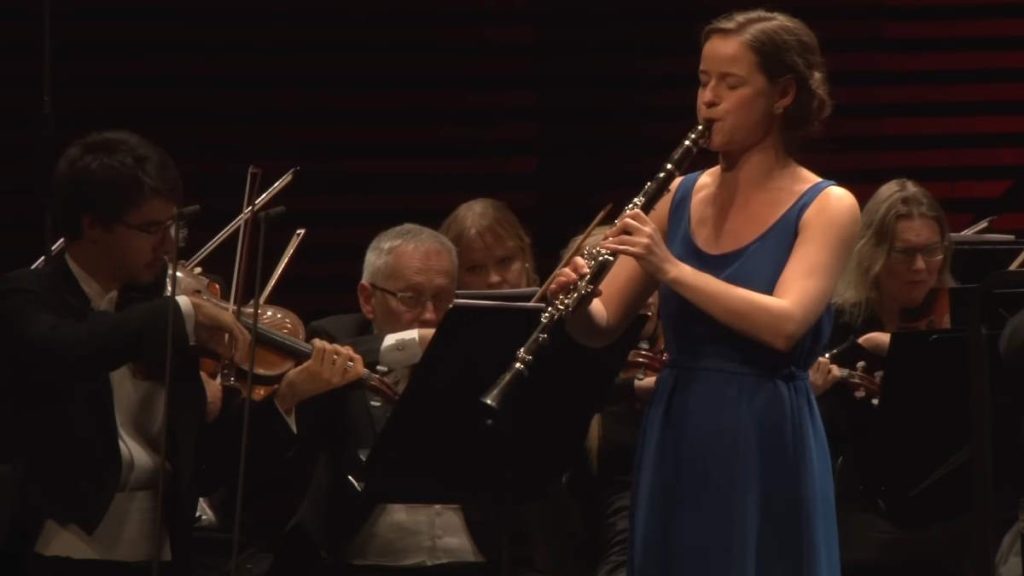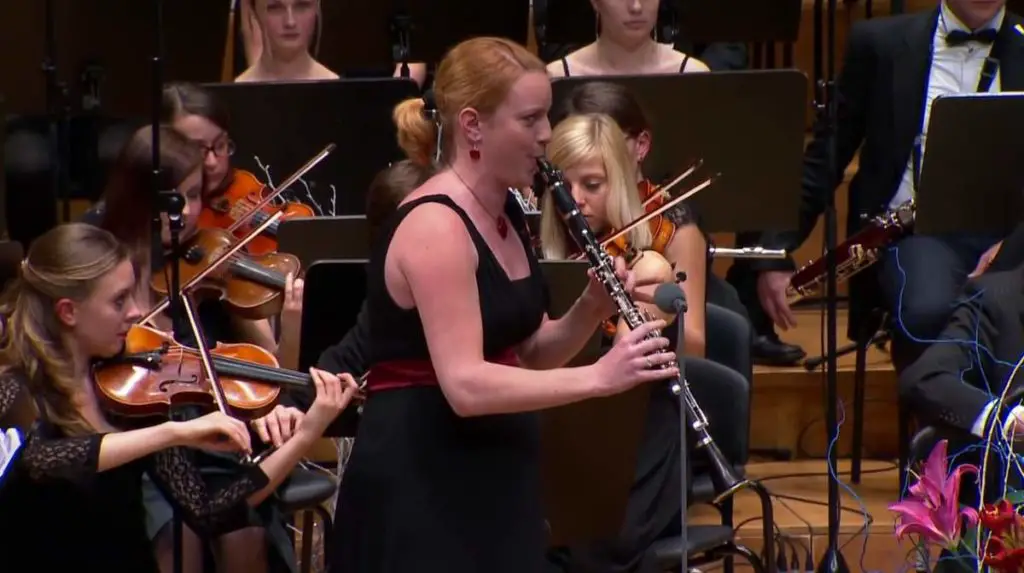Accompanied by the Iceland Symphony Orchestra, the Icelandic clarinetist (she is also a poet and a writer) Arngunnur Árnadóttir performs Wolfgang Amadeus Mozart’s Clarinet Concerto in A major, K. 622. Conductor: Cornelius Meister. This performance was recorded during Iceland Symphony’s Harpa, Reykjavík concert on September 10, 2015.
Wolfgang Amadeus Mozart’s Clarinet Concerto
Wolfgang Amadeus Mozart’s Clarinet Concerto in A major, K. 622, is a hallmark of the clarinet repertoire, showcasing the instrument’s expressive capabilities and Mozart’s mastery in composition. This concerto, completed in 1791, the final year of Mozart’s life, stands as a testament to his genius, blending elegance with profound emotional depth. The work was composed for Anton Stadler, a clarinet virtuoso and a friend of Mozart, who was known for his ability to exploit the full tonal and dynamic range of the clarinet, an instrument that was still relatively new in terms of its modern development at the time.
The concerto is noted for its lyrical melodies, the delicate interplay between the soloist and orchestra, and its innovative use of the clarinet’s capabilities. Mozart’s writing for the clarinet in this piece leverages the instrument’s wide range, flexibility, and unique timbre, from the warm, rounded lower notes to the bright, clear high register. This was particularly significant because Mozart composed it for the basset clarinet, an extended version of the instrument that included additional lower notes not available on the standard clarinet of the time. However, most modern performances use a standard clarinet in A or a specially adapted basset clarinet to include the original lower notes Mozart intended.
The concerto is characterized by its seamless flow and the organic development of thematic material. Mozart’s ability to weave intricate musical conversations between the soloist and the orchestra, and within the orchestra itself, is on full display. This work not only provides a showcase for the technical prowess of the clarinetist but also demands a deep musicality and interpretive insight to fully convey the emotional nuances embedded in the music.
Beyond its musical significance, the Clarinet Concerto is also important for its place in Mozart’s oeuvre and the classical music canon. It was one of his last completed works, and it reflects his mature style, marked by clarity, balance, and refined expressiveness. The concerto’s enduring popularity among audiences and performers alike attests to its timeless beauty and the universal appeal of its melodies.
Mozart’s Clarinet Concerto remains a favorite in concert halls worldwide, celebrated for its elegant melodic lines, rich harmonies, and the lyrical showcase it provides for the clarinet. Its creation at the end of Mozart’s tragically short life adds a layer of poignancy to the work, inviting listeners to ponder the composer’s legacy and the expressive potential of the clarinet. Through this concerto, Mozart not only expanded the repertoire for the clarinet but also left a lasting mark on the history of classical music, demonstrating the depth of expression that could be achieved through the orchestral concert format.
Movements
With start times in the video above:
- Allegro 0:27
- Adagio 12:58
- Rondo (Allegro) 20:07
1. Allegro
The first movement of Mozart’s Clarinet Concerto in A major, K. 622, is marked as Allegro, and it perfectly embodies the Classical era’s ideals of clarity, balance, and form. This movement, structured in the sonata-allegro form, begins with a graceful orchestral exposition that introduces the main thematic material. The themes presented here are characterized by their lyrical beauty and the elegance that is typical of Mozart’s mature style.
Following the orchestral introduction, the clarinet enters, taking up the themes introduced by the orchestra and expanding upon them with its own expressive nuances. The solo clarinet part is a marvel of Mozart’s writing, showcasing the instrument’s wide range, from the rich, warm tones of the lower register to the bright, clear sounds of the upper register. The movement is a dialogue between the soloist and the orchestra, with the clarinet weaving in and out of the orchestral texture, sometimes leading the musical conversation and at other times merging seamlessly with the ensemble.
The development section of the movement explores the thematic material in more depth, modulating through different keys and presenting the themes in varied forms. This section highlights Mozart’s mastery of musical form and his ability to create complex, yet accessible, musical structures. The development builds tension and complexity, which is then resolved in the recapitulation, where the main themes return in the home key of A major, bringing a sense of closure and resolution.
The cadenza, typically an improvised or written-out passage performed by the soloist alone, offers a moment for the clarinetist to showcase virtuosity and interpretive depth. Mozart did not write a cadenza for this concerto, leaving performers to choose or create their own, adding a personal touch to each performance. The cadenza serves as a bridge to the movement’s conclusion, with the orchestra rejoining the soloist for a final statement of the themes, leading to a graceful and satisfying end.
2. Adagio
The second movement of Mozart’s Clarinet Concerto in A major, K. 622, marked as Adagio, is widely regarded as one of the most sublime and expressive movements in the classical repertoire. This movement is a profound demonstration of Mozart’s ability to convey deep emotion through simple, yet profoundly beautiful, melodic lines. The Adagio stands in contrast to the more lively and dynamic first and third movements, offering a moment of introspection and serene beauty.
In this movement, the clarinet emerges not just as a solo instrument but as a voice that speaks directly to the listener’s soul. The orchestration is restrained, with the strings providing a soft, lush backdrop that allows the clarinet’s melody to soar. The opening bars introduce a theme of exquisite beauty, with the clarinet playing long, sustained notes that seem to float above the gentle accompaniment of the orchestra. The melody is characterized by its lyrical simplicity and the purity of its emotional expression.
The structure of the Adagio is straightforward, with the clarinet exploring variations of the main theme, each time adding new dimensions of emotion and depth. The movement does not follow a strict formal structure but is rather a free-flowing exploration of the thematic material. The dialogue between the clarinet and the orchestra is more intimate in this movement, with the orchestral parts carefully crafted to support and enhance the solo line without ever overshadowing it.
One of the most remarkable aspects of this Adagio is its capacity to convey a sense of longing and melancholy, while also providing moments of comfort and solace. The clarinet’s tone, with its warm, woody timbre, is ideally suited to this music, capable of expressing a wide range of emotions from sorrow to tranquil joy. The movement progresses gently, leading the listener through a landscape of sound that is both reflective and deeply moving.
The cadenza, a feature typical of concerto movements, is often incorporated into performances of this Adagio, providing a moment for the soloist to further explore the emotional depth of the music in a more personal and improvisatory manner. The movement concludes with a return to the main theme, bringing a sense of closure and peace.
Mozart’s Adagio from the Clarinet Concerto is a masterpiece of emotional expression, showcasing the composer’s unparalleled ability to touch the human heart through music. Its enduring popularity among both performers and listeners attests to its beauty and its power to communicate deep feelings without the need for words. This movement, with its serene and contemplative quality, stands as one of the pinnacles of Mozart’s musical achievements, offering a moment of transcendence in the midst of the everyday.
3. Rondo (Allegro)
The third movement of Mozart’s Clarinet Concerto in A major, K. 622, marked as Rondo: Allegro, brings the concerto to a lively and spirited conclusion. This movement is characterized by its cheerful mood, brisk tempo, and the playful interaction between the solo clarinet and the orchestra. The rondo form, with its recurring main theme interspersed with contrasting episodes, provides a perfect framework for showcasing the clarinet’s versatility and the joyful essence of the music.
The movement opens with the orchestra introducing the main rondo theme, a catchy and buoyant melody that sets the tone for the rest of the piece. The clarinet soon takes over, elaborating on the theme with virtuosic flourishes and expressive nuance. The rondo theme serves as a musical anchor throughout the movement, returning several times in various guises and acting as a point of departure for the soloist’s explorations.
The contrasting episodes offer a variety of moods and textures, ranging from lyrical and contemplative sections to more energetic and dynamic passages. These sections allow the clarinet to display its full expressive range, from the singing quality of its lower register to the brilliance and agility of its upper notes. Mozart’s writing here is masterful, weaving together the solo and orchestral parts into a seamless and engaging musical tapestry.
One of the hallmarks of this movement is its sense of spontaneity and joy. The music seems to dance, with lively rhythms and sparkling melodies that convey a sense of celebration. The clarinet’s role is both virtuosic and playful, demanding technical prowess from the soloist while also requiring a sense of musicality and charm to bring out the character of the piece.
The rondo form, with its repetitive structure, might seem simple on the surface, but Mozart infuses it with a wealth of musical ideas and subtle variations. The return of the main theme feels fresh each time, thanks to slight alterations in instrumentation, harmony, or dynamics, demonstrating Mozart’s genius for variation and development within a seemingly straightforward framework.
The movement builds to a spirited and joyful conclusion, with the solo clarinet and orchestra coming together for a final statement of the rondo theme. The energy and exuberance of the music leave the listener with a sense of uplift and delight, perfectly capturing the spirit of Mozart’s musical genius.
The third movement of the Clarinet Concerto is a fitting end to a work that spans a wide emotional and musical spectrum. From the elegant and expressive first movement to the serene beauty of the second, and finally, to the exuberant finale, Mozart’s Clarinet Concerto in A Major remains a masterpiece of the classical repertoire, beloved by audiences and performers alike for its depth, beauty, and technical brilliance.
Arngunnur Árnadóttir
Arngunnur Árnadóttir is a musician, poet, and writer. After studying clarinet playing with Einar Jóhannesson at the Iceland University of the Arts and Ralf Forster and Wenzel Fuchs at the Hanns Eisler School of Music in Berlin she was appointed as principal clarinetist at the Iceland Symphony Orchestra in 2012.

Arngunnur enjoys various forms of music-making. She has played chamber music at events such as the opening of Harpa Concert Hall in Reykjavík and the music festival Reykjavík Midsummer Music. She has performed with artists such as Skúli Sverrisson and Víkingur Ólafsson. Arngunnur has also received attention as a soloist with orchestra, working with conductors such as Daníel Bjarnason and Cornelius Meister.
As a writer, Arngunnur has produced two poetry books and a novel. Her latest book, Ský til að gleyma, came out in the fall of 2018.
Sources
- Clarinet Concerto (Mozart) on Wikipedia
- Clarinet Concerto in A major, K.622 (Mozart, Wolfgang Amadeus) on the International Music Score Library Project website
- Arngunnur Árnadóttir’s official website


